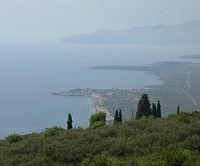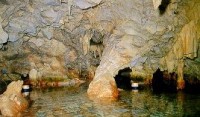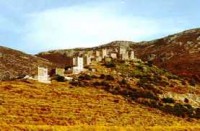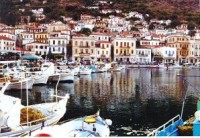If you look at a map of the Peloponnesian peninsula, the huge chunk of land that forms western Greece, you’ll see three long fingers jutting south into the Aegean Sea. One of them is the Mani. This rocky, ruggedly beautiful region, with part of the Taygettus mountain range, gets plenty of tourists but it’s still off the beaten path. It can be toured in a day or even less, though you need more than that to appreciate what it has to offer. John and I were glad we gave it several days.
 The Mani has a wild and varied history, from Homer’s day through the 20th century. We saw Byzantine churches, Frankish castles, abandoned monasteries, and secluded sandy beaches. One beach, Kalogria, is in a cove where the real-life Zorba the Greek danced. (If you’ve never read the book or seen the movie, don’t miss them.)
The Mani has a wild and varied history, from Homer’s day through the 20th century. We saw Byzantine churches, Frankish castles, abandoned monasteries, and secluded sandy beaches. One beach, Kalogria, is in a cove where the real-life Zorba the Greek danced. (If you’ve never read the book or seen the movie, don’t miss them.)
In spring the arid land is carpeted with purple wild marjoram and beehives that produce wonderfully rich honey, much of it exported. Scattered among them, over the hillsides, were dozens of towers. We learned that from the 15th century to as recently as 1870, the thick stone towers were the homes of feuding clans. The towers have high windows that were used for pouring boiling oil on approaching enemies. The feuds could last for generations, but a truce was always called at harvest time. Some towers have been remodeled and new ones built for today’s presumably non-feuding families. Happily, the only boiling oil you see today is in restaurants.
The gateway to the Mani is the quiet, pretty coastal town of Kardamyli, at the foot of the Taygetos range. We stayed in a gem of a hotel, the 25-room Liakoto. The owners, Fostis and Anna, welcomed us warmly and directed us to Old Kardamyli and to the stony paths up Vyros Gorge. On this enchanting walk, strewn with buttercup and purple vetch, we breathed the spicy scent of wild marjoram and listened to the bells of goats wandering among gnarled olive trees.
 When we could tear ourselves away from Kardamyli, we drove 52 miles south, through the stark, powerful landscape, to the Pirous Diros caves. These remarkable seaside caves, carved from limestone by an underground river, were places of worship in Neolithic times and hideouts for resistance fighters during World War II. John and I stepped into a little boat and, with a few other visitors, we glided in, floating through bizarre rock formations for 1.2 miles. In busier seasons there’s often a wait for the cave tour. It is worth it.
When we could tear ourselves away from Kardamyli, we drove 52 miles south, through the stark, powerful landscape, to the Pirous Diros caves. These remarkable seaside caves, carved from limestone by an underground river, were places of worship in Neolithic times and hideouts for resistance fighters during World War II. John and I stepped into a little boat and, with a few other visitors, we glided in, floating through bizarre rock formations for 1.2 miles. In busier seasons there’s often a wait for the cave tour. It is worth it.
 We continued another 14 miles to Vathia, at the southern end of the Mani. Vathia is an almost-deserted hilltop town of towers, and we liked its eerie atmosphere. In a nearby restaurant we tasted a regional specialty, syglino, pork sausage smoked with aromatic herbs such as thyme and oregano, with a touch of lemon peel. Another specialty of the Mani is the extra-virgin olive oil, which some say is the world’s best.
We continued another 14 miles to Vathia, at the southern end of the Mani. Vathia is an almost-deserted hilltop town of towers, and we liked its eerie atmosphere. In a nearby restaurant we tasted a regional specialty, syglino, pork sausage smoked with aromatic herbs such as thyme and oregano, with a touch of lemon peel. Another specialty of the Mani is the extra-virgin olive oil, which some say is the world’s best.
 Heading north in the little Renault, we stopped in Gythio, an unspoiled port town, and were completely charmed. We’d seen enough ruins for a while, and enjoyed just watching the fishing boats and the lines of octopus hanging above the wharves. Good seafood restaurants abound. We didn’t stay at the Hotel Aktaion, but I have heard that it’s a good choice: inexpensive, simple but comfortable, and every room with a balcony overlooking the harbor.
Heading north in the little Renault, we stopped in Gythio, an unspoiled port town, and were completely charmed. We’d seen enough ruins for a while, and enjoyed just watching the fishing boats and the lines of octopus hanging above the wharves. Good seafood restaurants abound. We didn’t stay at the Hotel Aktaion, but I have heard that it’s a good choice: inexpensive, simple but comfortable, and every room with a balcony overlooking the harbor.
We were at the far upper end of the Mani by now, on the east side, and headed for new adventures. The Mani is exceptional. The fierce fighting has been replaced with wonderful hospitality, and I would be happy to return. I’ve learned to raise my glass of ouzo and say “Gia Sas!” (Ya-sahs). It means hi, hello, and to your good health, and when the Greek people say it they mean it.
Note: Severe fires devastated parts of the Mani in 2007. Those areas are recovering.


Comments